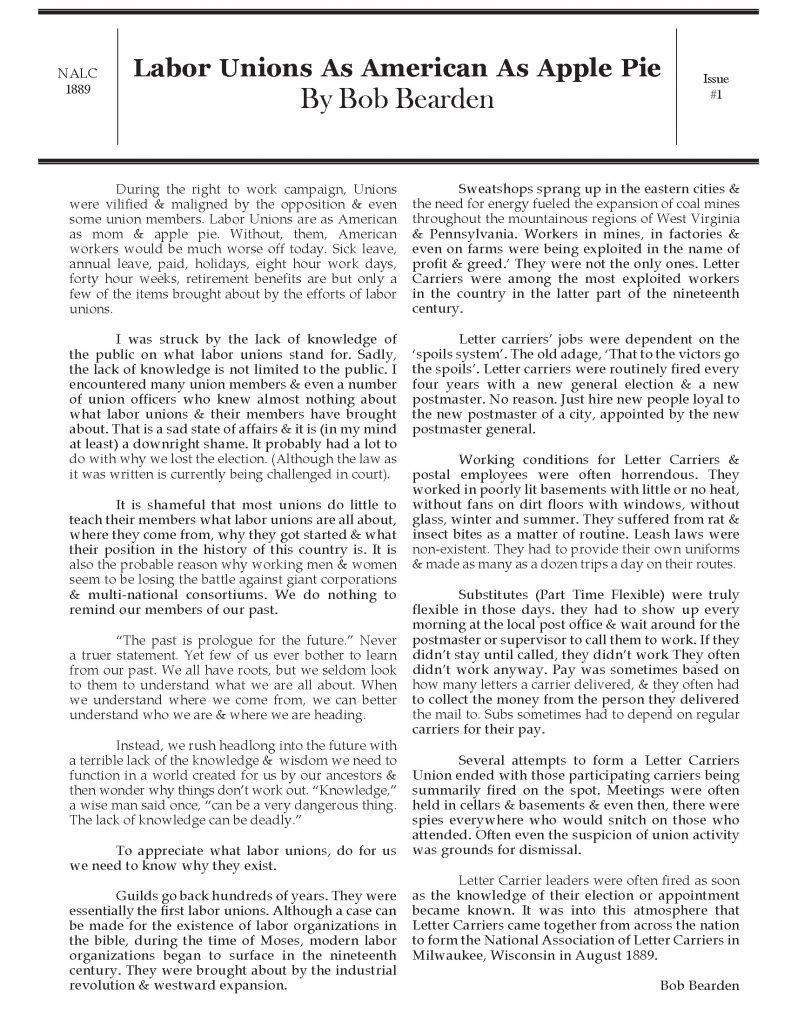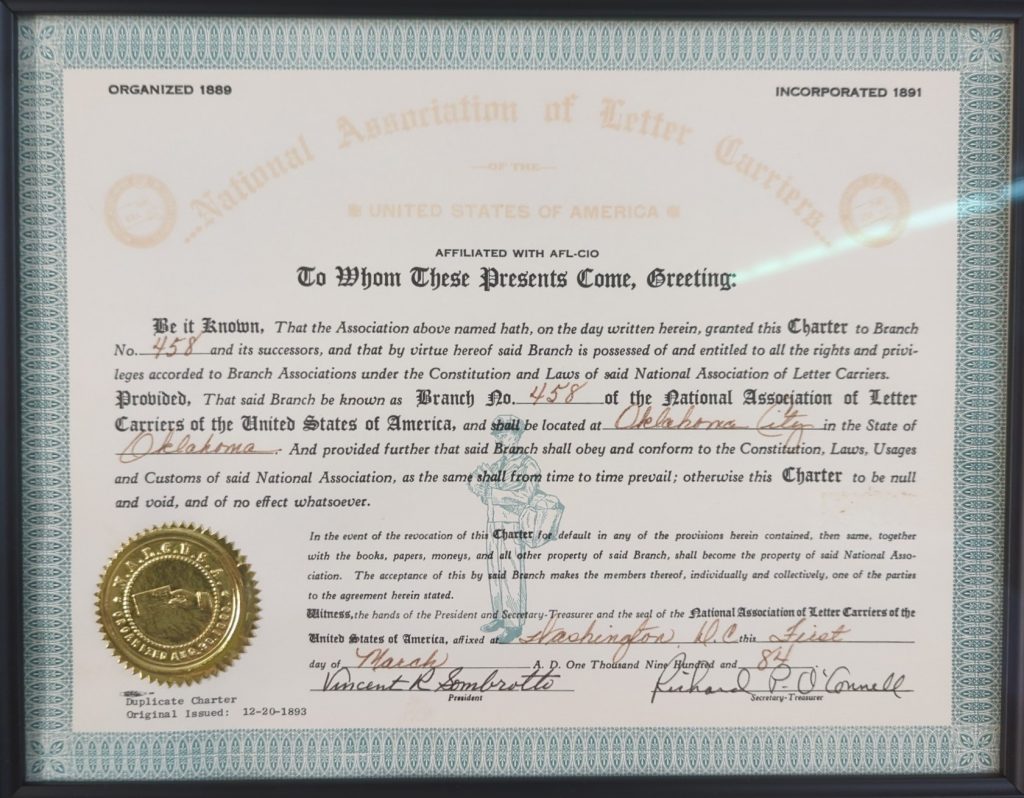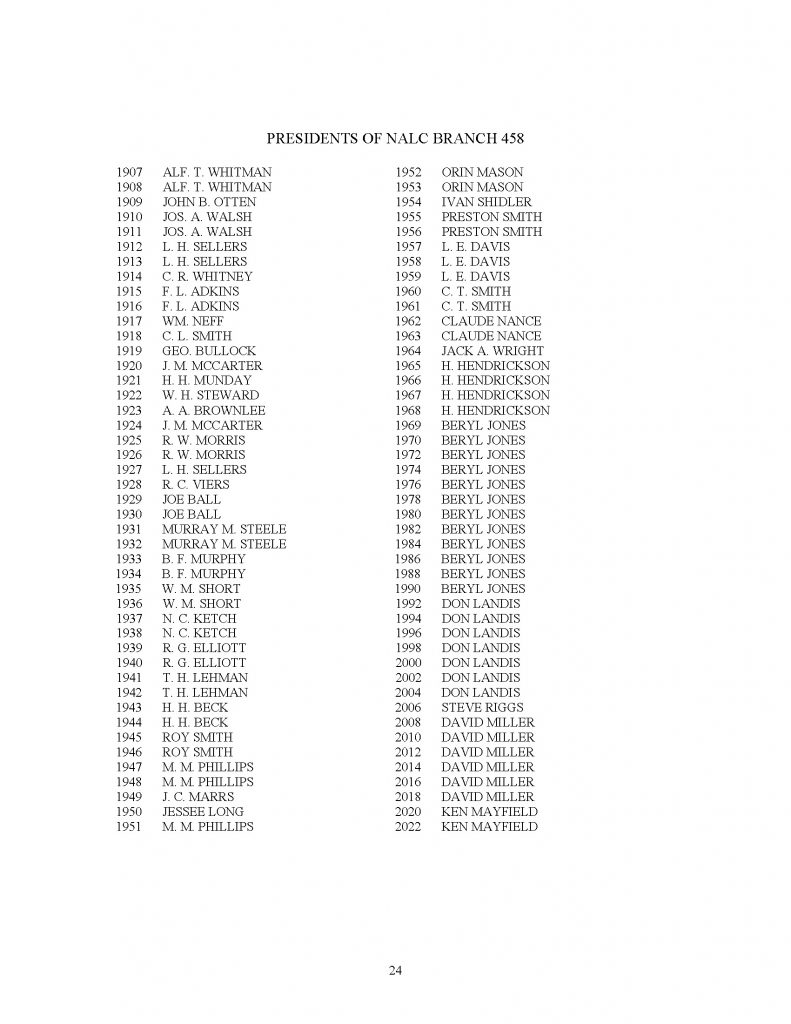*CLICK HERE* Centennial Edition Sooner Script 1993
Where we came from & how we became Branch 458 by current Treasurer and former Branch President Don Landis
Letter carriers were first employed in America shortly after the U.S. Post Office was formed by Congress in 1794. Letter carriers received no salaries but were permitted to collect 2 cents for every letter they delivered. Shortly thereafter, the employment of letter carriers was under what was called the “Spoils System” whatever political party was in power determined who were employed as letter carriers. In 1883 the Pendleton Act was passed by Congress which did away with the “Spoils System”, but also did away with the desire of Congress to listen and assist letter carriers. During this time letter carriers worked 365 days a year with no vacation time allowed, some local postmasters permitted some vacation time if the other carriers agreed to cover the route. In the mid 1880’s there was an organization named “Noble Order of the Knights of Labor” in which many letter carriers joined and this organization was pushing for an eight-hour day. In 1888 Congress passed the eight-hour day over the objection of the U.S. Post Office Department.
Prior to NALC
NALC Organized
In August 1889, a group of letter carriers many who were veterans of the Union Army that met annually at the “Grand Army of the Republic” formed the NALC on August 30, 1889, in Milwaukee, Wisconsin. In several locations across the country letter carriers who joined the union were immediately dismissed from their jobs.
Branch 458 Created
- December 20, 1893, a mere 4 years after NALC was organized, letter carriers in Oklahoma City joined the NALC and was the 458th local to do so. NALC Branch 458 became a part of NALC 14 years before Oklahoma became a state. It was another 11 years before the Oklahoma State NALC was formed in 1904.
- The wages in 1887 and continued through 1904 were $2.21 per day for letter carriers and substitute carriers were paid $1.00 per year to reported for duty every morning and again at noon to see if there was work available for them. Only when there was work for them did they get paid the daily rate.
- In 1902 a gag order was issued by President Roosevelt, prohibiting letter carriers from discussing working conditions and wages in public. In 1906 President Roosevelt issued another executive order allowing the Post Office Department to fire letter carriers without notice and without stating the reasons.
- In 1962 President Kennedy issued Executive Order 10988 which established formal labor relations in the federal government and recognized NALC as the sole representative of letter carriers. This executive order did away with the gag order and permitted letter carriers to petition and lobby Congress.
- Effective in 1969 the Branch 458 President became a full-time union position and Beryl Jones was elected to that position.
- Following the 1970 letter carriers national strike the U.S. Post Office Department became United States Postal Service (USPS). In July 1971, the first National Agreement between the USPS and NALC was negotiated and became binding on both parties. With the newly created National Agreement did it become possible to negotiate a local memorandum of understanding (LMOU) in Oklahoma City. The LMOU allowed the local parties to shape issues like annual leave policy. Prior to the LMOU the leave policy was that the senior carrier opted for all of leave periods they earned and wanted to take during the upcoming year, it then went down the seniority list. By the time it got to the junior carriers the only periods left were January and February for them to select.
- The National Agreement created a grievance-arbitration process, in which there was a formal procedure to address the differences between the NALC and the Post Office.
- In the late 1960’s and the early 1970’s Oklahoma City had numerous carrier routes that had either drive out routes or contract routes in which the carrier provided their own vehicles to use on transporting the mail to their route. The drive out route carriers were paid for the number of miles traveled, number of relays, etc. and they did not deliver parcels. There were parcel post route carriers that delivered the parcels and relays. Contract routes were routes in which the carrier signed a contract with the Post Office to provide their vehicle and were paid on a flat daily rate to do so. They had to provide the vehicle even on their non-scheduled day and vacation if the replacement carrier did not agree to provide theirs. There were walk-out routes and routes in which the carrier rode the bus to their route while taking the first relay with them. The parcel post route carrier when then spot the remaining relays in relay boxes spread out on the route and deliver all the parcels for that route. The Post Office motorized the drive out and contract routes and provided a vehicle for them to utilize. They also ended the bus routes and most walk out routes by giving them a vehicle also. While doing this also did away the need to have parcel post route.
- While casing up their mail in the office carriers would identify the mail for customers who have had moved and the carrier would write to new address on the mail piece to be forwarded to the new location. The Postal Service took those duties away from the carriers and created a central mark-up unit in which a clerk would stick a label with the new address printed on it on the mail piece. Ultimately, it became computerized mark-up in which the barcode was read and determined there was a change of address on record. A label was affixed to the piece of mail and forwarded to the new address.
- As the result of the 1978 national agreement there was many changes in the way route inspections and adjustments were conducted. One of the largest changes was that rather than every route being inspected every year it permitted only the routes that appeared to be out of adjustment had to be inspected. Routes with the same carrier on them, since the last inspection, with about the same mail volume and number of delivery stops were declared as static routes and did not need to be inspected. Since then, there has been several attempts to jointly, between the Postal Service and NALC, to make the inspection process a more cohesive undertaking.
- During the time frame of mid 1980’s through 1998 USPS and NALC developed a process to jointly have letter carriers involved in how they performed their job daily. This process was named Employee Involvement (EI), but the USPS unilaterally withdrew from the process.
- In December 1987 as the result of a national jointly lead endeavor to improve the labor climate in Oklahoma among various other items a grievance, discipline process as implanted in Branch 458, it was named Union Management Pairs (UMP). In 1998 management withdrew from UMP and EI without any explanation given locally other than local supervisors were not making decisions. About 2 years later Branch 458 was selected to test a new grievance, discipline process named Dispute Resolution Team. This test was a success, and it became the current grievance, discipline process currently utilized.
- Letter carriers since the beginning had sorted and cased all the mail addressed to their route until the Postal Service implemented Delivery Point Sequencing (DPS) in the early 1990’s followed by flat mail sequencing. With DPS automated equipment places the mail in delivery point sequence therefore greatly reducing carriers’ office time and eliminated the number of carrier assignments.
- The Postal Service introduced scanners into the carrier world first for Managed Service Points (MSP) and scanning parcels and accountable mail. Now they are utilized for tracking parcels, accountable mail but they are used to track the carrier through out the entire time they are on the street.
- Within the last few years, the Postal Service has tried many other programs to change the letter carrier job including having a few carriers case all the routes in the unit and the other carriers being on the street the entire tour.
- In 1994 the members voted to begin a scholarship program to provide a member’s graduating senior a scholarship. This program relies entirely upon donations from it’s member to fund it.
- Since 1993 Branch 458 has participated in the NALC Food Drive yearly and has received many recognitions for its member’s hard work.
- Branch 458 has historically been in support of Muscular Dystrophy Association (MDA) and have conducted money drives on its behalf.
- Branch 458 prides the training of its members and is proud of its record and what it has achieved in the representation of our members. Further our members have been promoted as the result of the training they have received. A member of Branch 458 (Roger Bledsoe) was elected to represent Region 4 as it’s National Business Agent that represents five states. Roger previously served as Regional Administrative Assistant (RAA). Currently Christy Bowers holds the position as RAA and David Miller works as Region 4 & 10 Regional Workers’ Compensation Assistant (RWCA).
- Several members of Branch 458 have been trained and serve as arbitration advocate.
- Branch 458 also have many members selected to various joint process, like DRT, route adjustment, etc.
- In 1995 Branch 458 purchased a building for the branch’s office and meeting place, the mortgage was paid off in 2004.


